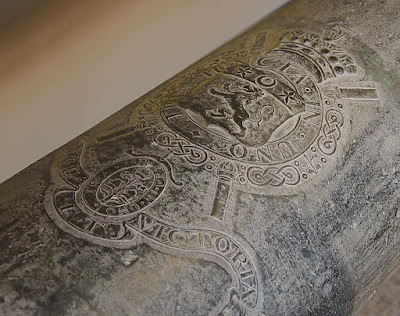The light 6 pounder battalion gun will likely to be the last piece to present, for many illustrations are available already & also many original and replique pieces exist to the present day. Hence, this one is well known.
Identifying the heavier position guns recommended for Field Service from the gentlemen of his British Majesties’ Royal Board Of Ordnance will be more of a challange.
John Armstrong, appointed Surveyor-General of the Ordnance (1722–1742) designed 3 ranges of ordnance during the 1730’s that were fixed in what I understand to be his 1736 Regulation. It should mark the starting point for all gun constructions up to 1762. Here, general Armstrong specified the basic construction principles for a Heavy, Medium, & Light range of guns. This 1736 Regulation by itself would already result in a wide range of different pieces. But even worse, it appears to have been employed as no more then a loose guide line, for I already found quite a few pieces that are clearly offside the 1736 Regulation figures when looking at the barrel weigths. A mass calculation of the sort John Muller provides in his “A Treatise of Artillery” on p. 49-50 of the 1768 edition has now become an important tool with my search to find the right constructions. Anyone who wants to try good fun mathematics for himself—watch out for the typo on page 50. A cubic foot of gun metal weighs 549 pounds, not 459! See page 3 in the same book. Took me a while, till I found the annoying error here.
My first arranged sheet illustrates the Armstrong 1736 Regulation heavy 12-pounder battery or battering gun.
I continue to believe the cannon seen in David Morier’s painting can really be identified as an authentic piece from among the range of ordnance fielded during this period.
By placing the Cannonier from the Morier painting next to my 12-pounder barrel, it is obviously too large a construction. The diameter of the base ring is certainly bigger than that of the cannon seen in Morier’s painting. Another heavy range 12-pounder construction—a barrel 7 foot 6 or 8 inch long—would arrive at about the same diameter. Somewhat slimmer was the 6 foot 7 inch Armstrong construction of his Medium range of ordnance. But this barrel would be too short. We clearly see a long barrel here. The only piece left would be the ‘Long 6’ with a barrel 8 foot long. Here it is.
Now lets have a closer look. For a quick check, I needn't bother to draw its carriage. It already exists. John Muller provides the illustration, presenting it as the type of carriage that was in use by the time of his books 1st edition in 1757.
Now this seems to make a charming match. I believe the piece we see in Morier’s painting is with near certainty the 8 foot heavy 6-pounder. The Imperial & Allied Army’s Order of Battle for the year 1747 lists 26 3-pounders for 14 British battalions—possibly mounted on ‘Galloper’ carriages, 27 6-pounders of which a number must have been of the light 4.5 foot construction. John Muller mentions in his book that such a piece, employed at the battle of Laufeldt July 1747, was testet at Woolwich in the early 1750’s. The guns seen in the painting must be more then a dozen heavy pieces, but only 6 British 12-pounders were fielded that year. Hence, a many of the big guns we see here must have been ‘Long 6’ guns.
The piece also seems to have seen service in the Seven Years' War. With the commencement of the 1761 summer campaign, Prince Ferdinand's staff papers have a detailed record of the British artillery. Apart from the British line artillery brigades consisting of ‘Light’ 6 & 12-pounders along with some 5.5 inch howitzers, there had also been 3 heavy brigades of the artillery park. 8 ‘Heavy’ 12-pounders, 8 ‘Medium’ 12-pounders (the ones that were at Minden 1759 with a 7-horse draught), & 8 ‘Heavy’ 6-pounders. The ‘Medium’ 12 & ‘Heavy’ 6-pounders reinforced Granby's hard pressed division July 15-16 on the Dinker-Berg in the battle of Vellinghausen.
Earlier this summer I researched this battle in more detail together with Charles Grant, as he is writing on his next volume of his "Wargaming in History" series. We had a wonderful time here. Charles provided me with the following interesting bit. Its from Walter Evelyn Manners, "Some account of the military, political, and social life of the Right Hon. John Manners, marquis of Granby", 1899. Loosely quoting: The Scottish officer "Sir James Innes Norcliffe observed a ‘serjeant’ of Campell's Highlanders serving a ‘Long 6’ which the serjeant had carefully masked with boughs. The Highlander surveyed the effects of his excellent practice, ejaculating: Now a round !—Now a grape ! at intervals, as he varied his load." It must have been the severe cannonade in the early morning 16 July. Gun crew killed or disabled. The couragious Highlander served the piece instead. Sir James added that after the action he noticed grape-shot sticking in some of the dead Frenchmen like grains of Indian corn in the cob, and the round-shot had occasionally taken two or three of the enemy in a line. It is speculated if it was the Highlanders piece which wrought such havoc among the French [high] aristocracy, for 3 generals—all related—were killed with a single round very near Vellinghausen. That's where James Innes must have had its battle position as there used to be a ground feature on the slope of the Dinker-Berg facing towards Vellinghausen, that has been known among the locals as "Sir James Innes" since the days of the battle. Now it is gone. It was a fold in the ground with much the character of a sunken road. A natural trench much like the Bloody Lane at the Antiedam battle of the American Civil War.
Now back to the subject. There have been other 6-pounder constructions. The 1754 Regulation lists a 5 foot 1 inch piece—that’s only 7 inches or two shot diameters longer then the 4.5 foot Light 6-pounder battalilon gun. I wouldn’t entitle a 5 foot 1 barrel a ‘Long 6’, but I might be wrong here.
Since the death of John Armstrong 1742, and well into the 1750’s, the gentlemen in Woolwich tested a great number of various designs to find the best length & metal strength for its gun constructions. The 1754 Regulation shows the ones that seem to have been accepted for service in the field. The question remains: how many of the new pieces would have been cast to be fielded in the SYW? Possibly not all that many as milord Sackville had difficulties finding enough light guns with no more then a 6 horse draught earlier in 1759. Possibly those old 8 foot 6-pounders—tested in Flandres in the preceeding war—had to be fielded for lack of alternative in 1761.
Below see my scale drawing of the "Long Six" along with all the essential data found to it.
I believe this is the very piece that is seen in the David Morier painting's right foreground. After doing this 6-pounder I decided to do the entire range of the M1736 heavy Armstrong pieces. Below see the heavy 3-pounder.
Next comes the 24 pounder.
Finally, the heavy 12 pounder.
The afore 4 pieces had been the mainstay of the British artillery during the 1740's. (There is also mention of a heavy 9 pounder fielded in Flandres in 1747. I did not bother to do this piece. It was a 9 foot barrel, like the 12 pounder & apparently became obsolete by around 1750). Only few new models started to arrive during this period. The new light 6 pounder by around 1745 with the War of the Highland Rebellion and a light & medium 12 pounder construction by the time of the Seven Years' War. I believe that is all there is.
The next piece I present here is the ‘medium’ 12-pounder—fielded from the mid 1750's on, no earlier to my understanding.
An original barrel—a cast of 1760—is on display in the US Watervliet Arsenal Museum, New York Sate. See images of this piece below.
 |
| British Armstrong design ‘medium’ 12-pounder image published here with kind permission of Bill Maloney http://www.williammaloney.com |
 |
| The barrel's 1st reinforce has the Royal Arms of His Majesty image published here with kind permission of Bill Maloney |
 |
| The barrel's chase has the arms of John, 1st Earl Ligonier, General-Master of the Ordnance 1759-1763 image published here with kind permission of Bill Maloney |
 |
| Front view of the ‘medium’ 12-pounder image published here with kind permission of Bill Maloney |
Finally, with the below 2 sheets, I present the two models of the Armstrong design ‘light’ range of ordnance fielded during the Seven Years' War in Germany—the light 6 also being fielded during the 1747-1748 campaigns in Flandres during the War of Austrian Succession.
Below see the complete contemporary draft of the British light 6-pounder piece originating from the digital archive of the Germanisches National Museum, Germany, with its carriage including the lockers & its associated limber.























Great work.
ReplyDeleteWill you write about howitzers in Detail too?
Thank you for your great effort.
Cheers,
Damnitz
I believe I will. But not within short.
ReplyDeleteNeed to return to my core business — that is painting more troops.
Thank you. I can see that your blog posts are very detailed and need a lot of work and research.
DeleteCheers,
Damnitz
Congratulations for this magnificent blog.
ReplyDeletesuch an impressive collection!
ReplyDeleteWhere do you get your figures?
This comment has been removed by a blog administrator.
ReplyDeletewow, nice information, the details was accurate and best article, keep sharing.
DeleteAlexa echo dot
Very informative article, your blog is a treasure trove! Behind all your posts are thorough research and devotion on the period! Many congrats!
ReplyDeleteWe have two of what I beleve are 12 pound Howitzers of Royal Indian Artillery on the 19th century. I'd like to know their history, in case you are aware of it. Can send you pics on mail.
ReplyDeleteSorry, 19th century artillery is outside my studies. Not so well informed here. But thanks for the offer.
ReplyDeleteWere the munitions boxes on the light 6 and 12 pound guns removed when the piece was being fired? Or, were the boxes permanently attached to the gun carriage?
ReplyDeleteJim
I really like your blog.. very nice colors & theme. Did you create this website yourself or did you hire someone to do it for you? Plz respond as I'm looking to create my own blog and would like to find out where u got this from. spanish american war service files
ReplyDeleteI did it myself by choosing a theme for the general looks of the layout. Unfortunately I cannot recollect the name. Meanwhile, google seems to have updated its theme selection. I cannot find it anymore.
ReplyDeleteI'm sorry to be of little help here.